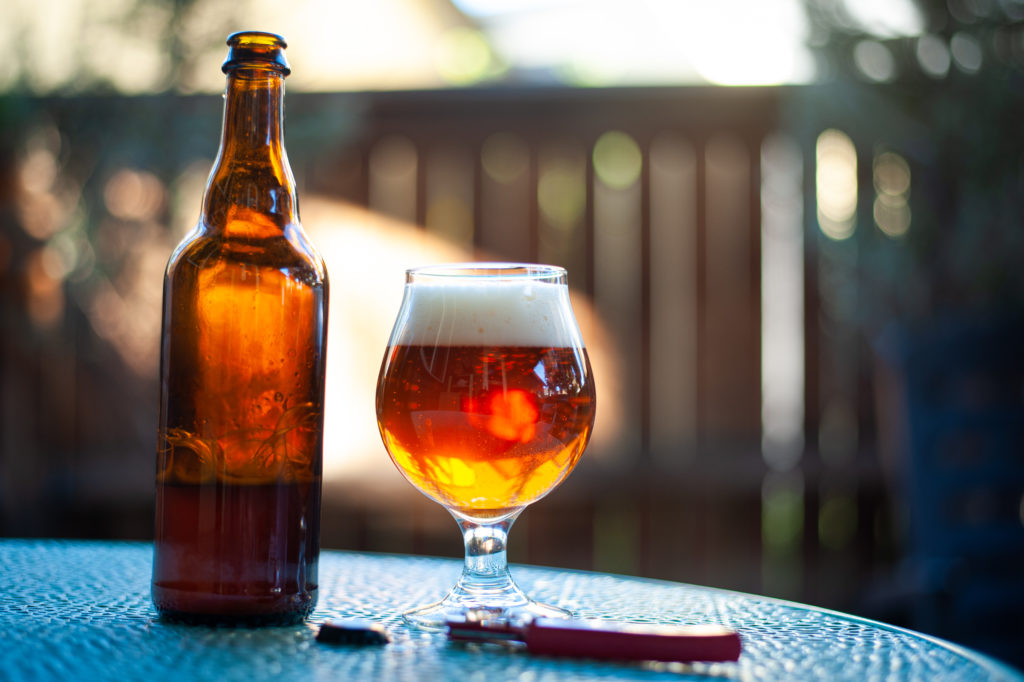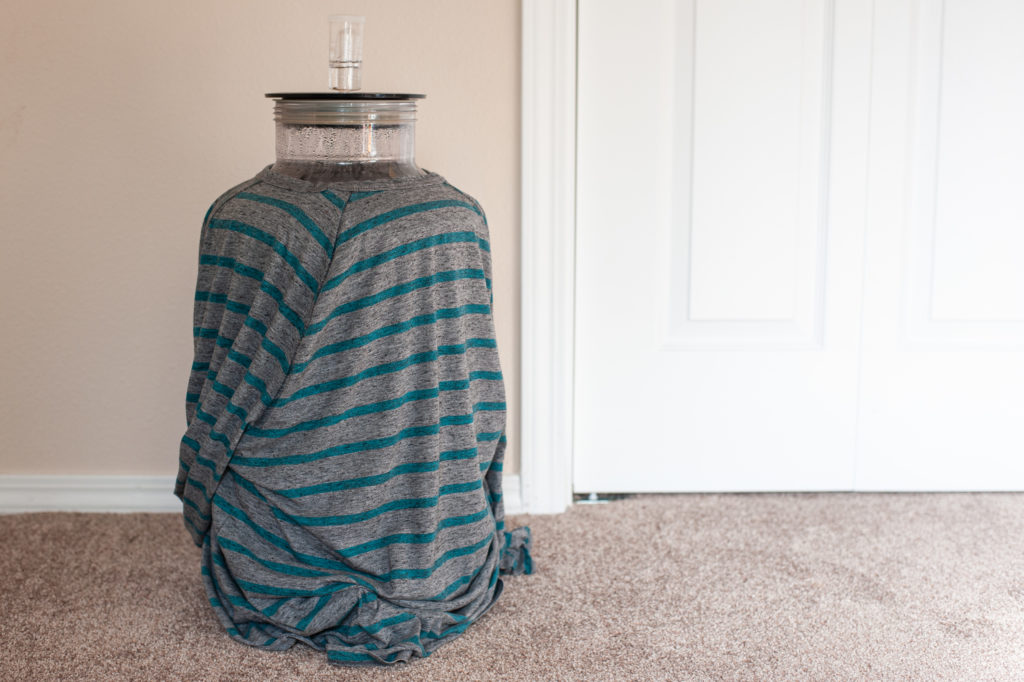Saison Season 2021, Part 2: Le Lumière Ambrée

For my first 80ish batches of beer, I rarely reused yeast. Sure, there were exceptions: I’ve dried my own kveik, repitched on a Roeselare cake, and I’ve got a solera going. But for less complicated or less exotic beers, I generally just pitched a new pack each time. Yeast—especially dry yeast—was cheap and readily available. Why bother with washing, storing, or freezing?
That started to change around the time Bend’s brew shop closed down, in May of 2020. Without a local source for yeast, I needed to pay for shipping, which of course raised the cost of brewing. Around the same time, I also switched to fermenting in kegs with floating dip tubes, which made it really easy to ensure my yeast didn’t get infected between batches.
As a result, I’ve been reusing yeast cakes for my non-dry-hopped beers, and the results have been fantastic. I’m currently on the 4th generation of an Omega Bayern cake that I’m hoping to stretch out to at least 10 batches, and I’ve been reusing dry yeast like W-34/70 and US-05, too.
While it’s not a keg-fermented cake (it lives in a ported Big-Mouth Bubbler), I’ve also kept the pitch of Omega C2C Farmhouse that I used to make my rustic blonde saison going for three generations—it’s been continuously in use since December 2020. Right now it’s housing a dark saison that I’ll bottle around Christmas, but before that it held an amber Brett saison: one that built on the success of the blonde saison and layered in some darker malts for a more complex, bready backbone. Whereas the blonde saison used all Saaz hops, this one incorporated Loral and Hallertau Blanc—still at a reasonable 30ish IBU—to help give it a more assertive hop character that would balance the maltiness.
What’s in it?
The Vitals
- Method: BIAB, full-volume mash
- Batch size: 3.5 gallons
- Mash: 152F for 75 minutes
- Boil: 60 minutes
- Fermentation: Room temp (~74F) for 5 months
- OG: 1.054 (13.4 Bx)
- FG: 1.004 (5.7 Bx)
- ABV: 6.6%
- IBU: 29
The Grain
- 4 lbs Briess 6-Row Malt (60.2%)
- 2 lbs Mecca Grade Metolius Munich-style Malt (30.1%)
- 0.5 lbs Franco-Belges Caramel Munich 40 (7.5%)
- 0.15 lbs Fawcett Pale Chocolate (2.3%)
The Hops
- 10g Loral [10.5% AA, 16.7 IBU] @ 60 minutes
- 20g Loral [6.6 IBU] @ 5 minutes
- 20g Hallertau Blanc [9.7% AA, 6.1 IBU] @ 5 minutes
The Rest
- Yeast: Omega C2C Farmhouse (OYL-217) cake from Rustic Saison
- Water: 4.5 gallons Bend tap + 0.5 tsp CaCl2, 0.5 tsp gypsum, and 2g lactic acid 88%
- Presumed Water Profile: Ca2+ 70 | Cl– 65 | SO42- 67 | Mash pH 5.37
» BeerXML Download «
How’d it go?
Brew day was a total breeze, which is kind of the norm now that I’ve got my system so dialed in. It was so breezy, in fact, that I didn’t even take a preboil gravity reading. After the boil, the OG came in just a hair under expected at 1.053 (vs. a 1.054 prediction). I chilled the wort to around 75 degrees Fahrenheit and transferred it directly onto the cake from La Blonde Africaine, which I had bottled during the boil. (There was still maybe a cup or two of finished blonde saison in there, so I guess you could technically call this a solera. But I digress…) From there, I moved the BMB into my office, which stays more or less at an even 74 degrees and left it to do its thing.

Fermentation kicked off right away, and it was bubbling within a few hours. A week after pitch, the SG was already down to 1.007 and a sample showed the Brett was already hard at work. I didn’t test the gravity again for another four months, and didn’t bottle it for another month after that. So this one sat in primary for five months, all told.
As I said in my post about this beer’s blonde sibling, the C2C Farmhouse culture works fast. The Brett character comes out right away, and while it intensifies with time, it’s not going to get hugely more Bretty if you leave it in primary for months. The gravity doesn’t drop much further, either—this one only dipped another three points from my first sampling seven days into fermentation to bottling months later.
So why did I wait? Well, I was lazy, and I already have way too much beer bottled and ready to drink. Simple as that.
How’s it taste?

Appearance: After several months in the bottle, it’s close to clear but not quite there. There’s still just a very mild haze that I have gotten with every single Brett beer I’ve ever made. The color almost leans a firey orange, but I’d still put it squarely in the amber camp. And the head—voluminous and white at first, eventually settles into a thin cap that sticks around as long as the beer does. I can thank the high carb for that, I guess. There’s some nice lacing on the glass, but not as much as I usually get in my non-Brett beers.
Aroma: Where my pale saison with freekeh led with saison aromatics, this one presents much heftier Brett notes—earthy tones of hay plus a very light acidity. The classic saison aromas are there, too; mostly clove, not banana, with a bit of pear. The malt comes through mainly as a biscuity, cookie-like undertone.
Taste: While not sour in any sense of the word, it’s sharp with the same light trace of acidity you get from the nose. The first sip from my most recent pour had an almost bloody note that disappeared after the beer had been decanted for a few minutes. Compared to the freekeh Brett saison, this beer has much more going on in the malt department—caramel flavors mix well with the earthy Brett and saison spice phenols to create a taste that almost reminds me of zucchini bread. I hoped to get more hop character into this beer by using Loral and Hallertau Blanc, I can’t distinguish any specific hop flavors. Nevertheless, the bitterness balances the malt and yeast complexity very nicely.
Mouthfeel: Very dry, despite the high (for a saison) FG. It leaves a drying sensation on the tongue that demands another sip. The high carb definitely helps here, but this is a beer I’d want more of even if it was totally uncarbed.
Would I brew it again?

I honestly don’t know if it’s possible to make a bad beer with this culture. The yeast simply does so much of the heavy lifting that it almost doesn’t matter what you throw at it, in terms of grain and hops. So yes, I’ll keep making this beer—or something similar—for as long as this yeast cake keeps delivering. For this specific amber grain bill, I think I’d add just a touch more crystal malt, maybe something darker like Simpsons Extra Dark, just to give it a stronger toffee character. But any changes I’d make would be small.

Leave a Reply